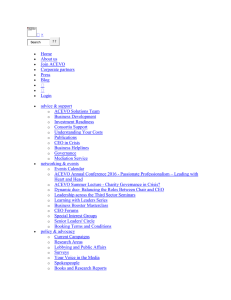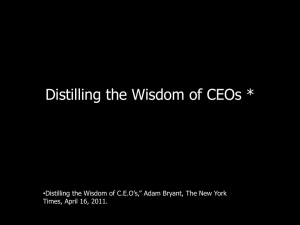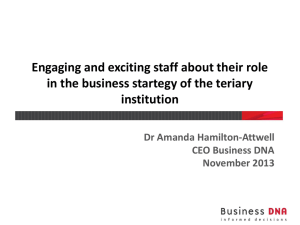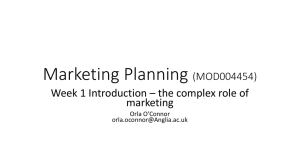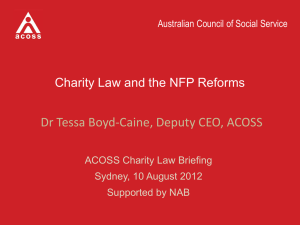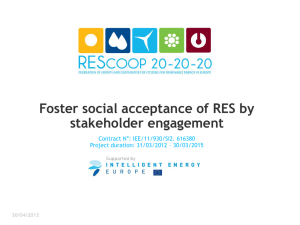Seb Elsworth – For the public benefit: can you prove it?
advertisement
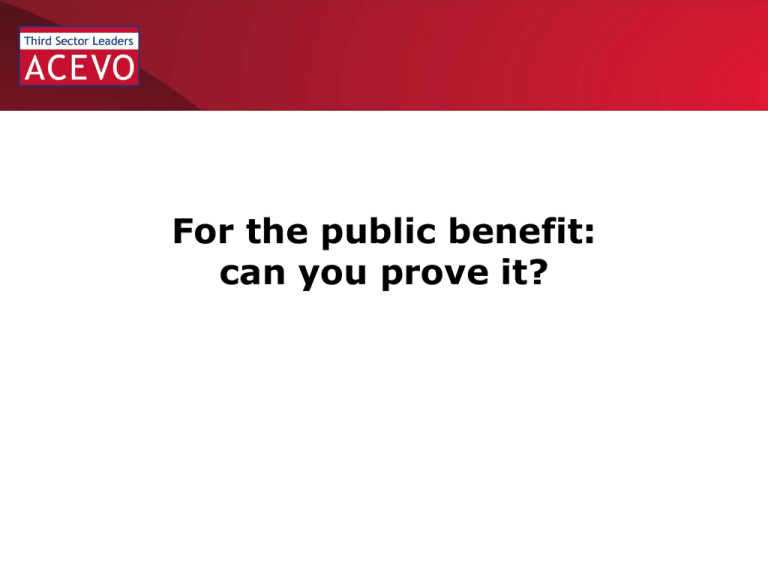
For the public benefit: can you prove it? About ACEVO Charitable Uses Act 1601 (also known as the Statute of Elizabeth) • The relief of the aged, impotent and poor people; • The maintenance of sick and maimed soldiers and mariners, schools of learning, free schools and scholars in universities; • The repair of bridges, ports, havens, causeways, churches, sea-banks and highways; • The education and preferment of orphans; the relief, stock or maintenance of houses of correction; • The marriages of poor maids; • The supportation, aid and help of young tradesmen, handicraftsmen and persons decayed; • The relief or redemption of prisoners or captives; • And the aid or ease of any poor inhabitants concerning payment of fifteens, setting out of soldiers and other taxes. What the 2006 Act says… ‘Charitable purposes’ that are ‘for the public benefit’ • • • • • the prevention or relief of poverty; the advancement of education; the advancement of religion; the advancement of health or the saving of lives; the advancement of citizenship or community development; • the advancement of the arts, culture, heritage or science; • the advancement of amateur sport; • the advancement of human rights, conflict resolution or reconciliation or the promotion of religious or racial harmony or equality and diversity; • the advancement of environmental protection or improvement; • the relief of those in need, by reason of youth, age, ill-health, disability, financial hardship or other disadvantage; • the advancement of animal welfare; • the promotion of the efficiency of the armed forces of the Crown, or of the efficiency of the police, fire and rescue services or ambulance services; • other purposes currently recognised as charitable and any new charitable purposes which are similar to another charitable purpose. Public Benefit • 'Public benefit' is the legal requirement that every organisation set up for one or more charitable aims must be able to demonstrate that its aims are for the public benefit if it is to be recognised, and registered, as a charity in England and Wales. Two principles Principle 1: There must be an identifiable benefit or benefits Principle 1a: It must be clear what the benefits are Principle 1b: The benefits must be related to the aims Principle 1c: Benefits must be balanced against any detriment or harm Principle 2: Benefit must be to the public, or a section of the public Principle 2a: The beneficiaries must be appropriate to the aims Principle 2b: Where benefit is to a section of the public, the opportunity to benefit must not be unreasonably restricted: • by geographical or other restrictions or • by ability to pay any fees charged Principle 2c: People in poverty must not be excluded from the opportunity to benefit Principle 2d: Any private benefits must be incidental Duty of Trustees Charity trustees must: • ensure that they carry out their charity's aims for the public benefit; • have regard to CC guidance on public benefit (when they exercise any powers or duties where that may be relevant); and • report on their charity's public benefit in their Trustees' Annual Report. Guardian - 2009 Private schools face losing charitable status over lack of free places Four charities – two private schools and two care homes – will learn today that they have failed a "public benefit" test to justify their charitable status, after the first 12 inspections by the Charity Commission The private schools are criticised for failing to provide enough bursaries, while one of the care homes was found to be operating as a hotel rather than a residential facility for the elderly and infirm. Current case • Independent Schools Council granted a judicial review of the Charity Commission’s guidance on fee charging charities • “The Independent Schools Council says the Charity Commission made an error of law by interpreting the term "public benefit" to mean that those in poverty should not be excluded, and is hoping for the condition to be removed from the guidance as a result of the case.” Demonstrating your impact “The Board has reviewed the Charity Commission’s general guidance on public benefit.” Is that enough? Drivers for improving board performance Challenge of Accountability – Greater role in the delivery of public services – New market structures – Greater demands from our funders and donors to demonstrate impact – More information available to the public – Continuous improvement for the organisation 13 Transparency Manifesto: 1. Our organisation demonstrates the change it is trying to bring about, how it works to bring about that change, and the progress it has made so far. 2. Our communications are transparent, accurate and written so that they can be understood by their intended audiences. 3. Our leadership champions a commitment to accountability and transparency. 4. Our organisational structure, including trustees, is easily accessible to the public, and we list key responsibilities for senior staff members. 5. Our trustee report and annual accounts are prepared to statutory requirements and submitted on time. 6. Relevant information (e.g. annual report, accounts, impact report) is easily accessible ideally no more than 3 keystrokes from our website’s homepage. 7. Our organisation monitors and evaluates what it does, and shares its learning. 8. Our organisation provides mechanisms for stakeholders to help shape what it delivers. 9. Our organisation publishes an easily accessible suggestions and complaints procedure for beneficiaries and supporters. Five principles • What is the problem you are trying to solve? • What are you doing to solve the problem/What are your activities/services? • How does what you do create change/What is your theory/hypothesis on this? • How are you doing against your goals/What progress have you made? How do you know this? • Evidence of learning- If you had to stop doing one thing what would that be? What has the organisation changed from the lessons it has learnt? Background to the theory of change • The objective of the theory of change is to map ACEVO’s activities to its outcomes. This results in a set of outcomes that ACEVO as an organisation aims to achieve. • These outcomes form the basis of the evaluation framework – they provide a set of things that ACEVO can track progress towards. • These slides show the theory of change mapping that we did for ACEVO. 17 Theory of change overview ACEVO’s activities ACEVO’s internal and intermediate outcomes Members run more effective services for beneficiaries 18 Members run their organisations better ACEVO improve the environment in which third sector leaders operate The third sector thrives Theory of change for support work Members feel part of a peer group ACEVO’s support must be good Helplines Members must be aware of the existence of support Emotional Support Members must need the support Support from professionals CEOs feel supported by existence of practical and emotional support CEOs receive useful emotional and practical support Members feel more confident and happier in running organisation Members have access to expertise they need Mentoring Consultanc y from corporate partners CEOs receive relevant emotional and practical support Members run their organisations better Members develop skills they need as CEO Members run more effective services for beneficiaries CEOs receive reliable emotional and practical support CEOs receive timely emotional and practical support The third sector thrives Theory of change for peer support ACEVO must have an active membersh ip Learning from outside membership Members feel part of a peer group Members develop their own networks Conferences ACEVO events must have a good reputation for networking ACEVO must know the problems its members face Special interest groups Courses Peer learning Members meet people in a similar position (other CEOs & leaders) Members have sense of solidarity from talking to other CEOs Members learn from other CEOs Members identify opportunitie s for partnership and collaboration Members feel more confident and happier in running organisation Members have access to expertise they need Members run their organisations better Members run more effective services for beneficiaries The third sector thrives Theory of change for information and training Lobbying CEOs to improve ACEVO knows what its members need informati on on CEOs understand room for improvement Conferences Courses CEOs want to improve Publications Members know where to find informati on The third sector thrives Research Website Members access information Members feel more confident and happier in running a organisation Members develop skills they need as CEO Training Members run more effective services for beneficiaries Members feel more confident and happier in running a organisation Ad hoc enquiries Disseminating relevant information Members run their organisations better Members feel informed Members feel part of a peer group Theory of change for press and policy work ACEVO must know what its members want ACEVO must know the right people to influence & have good relationsh ips with them ACEVO must have a good profile ACEVO must understand policy environmen t & context for decision makers Contact with decision-makers including written briefings Enquiries, commissions and reports Responding to consultations Helping members raise their agenda with decisionmakers Policy-makers and public aware of and value third sector’s work / contribution Policy-makers and public aware of issues affecting third sector Networking Policy-makers and public well informed on issues and possible solutions Contact with influencers including written briefings Policy-makers and public see the need for change Press work The standing and perception of the third sector amongst decision-makers & the public is improved ACEVO improves the environment in which third sector leaders operate Policy is changed Members feel valued and respected for work ACEVO’s influence is raised Members run their organisations better Members run more effective services beneficiaries The third sector thrives ACEVO’s measurement plan • • • • • • • • • • An annual survey of members; Survey of non-members; An annual survey of former members; Case studies; Course and conference evaluations; Website and helpline analysis; Press analysis; Interviews with journalists and policy-makers; Interviews with third sector leaders; and Impact anecdotes. Any questions
